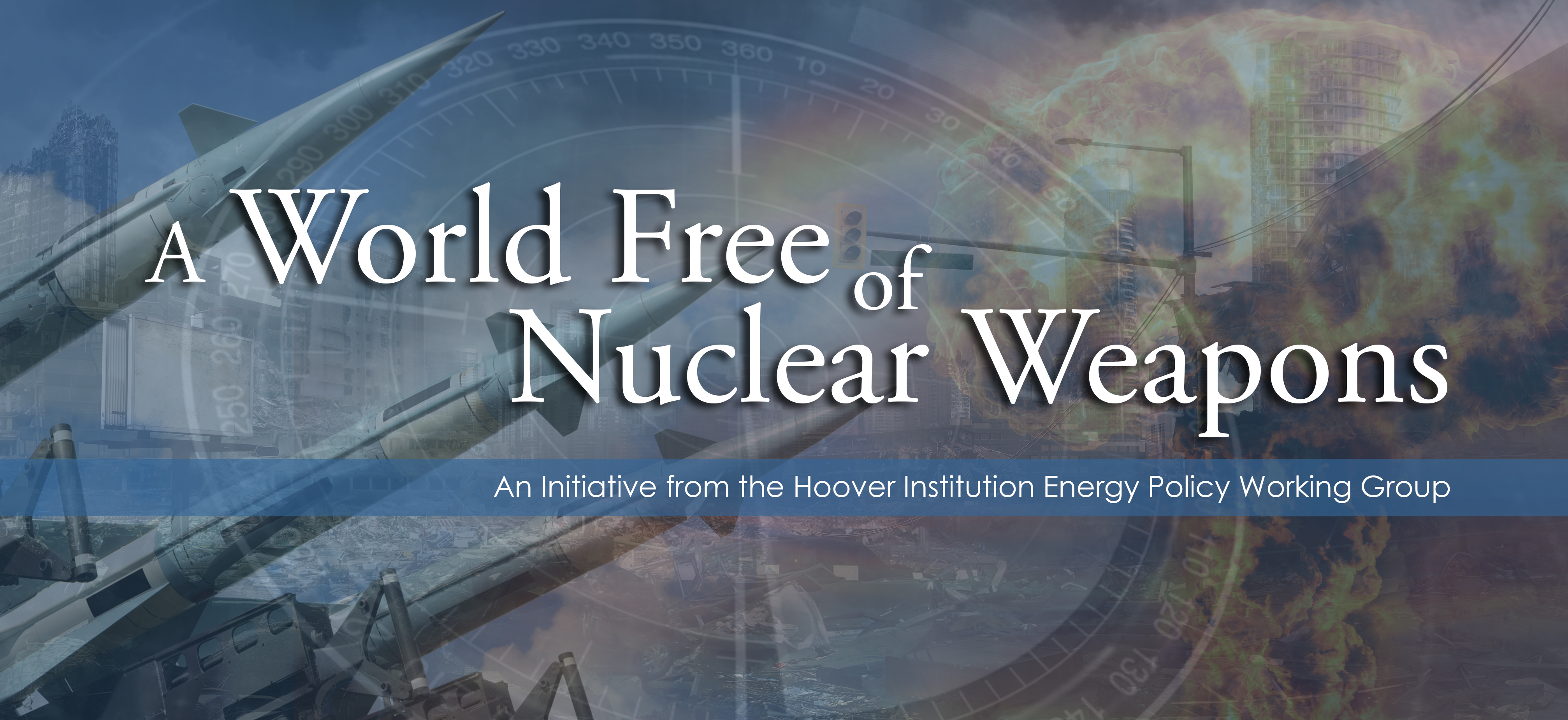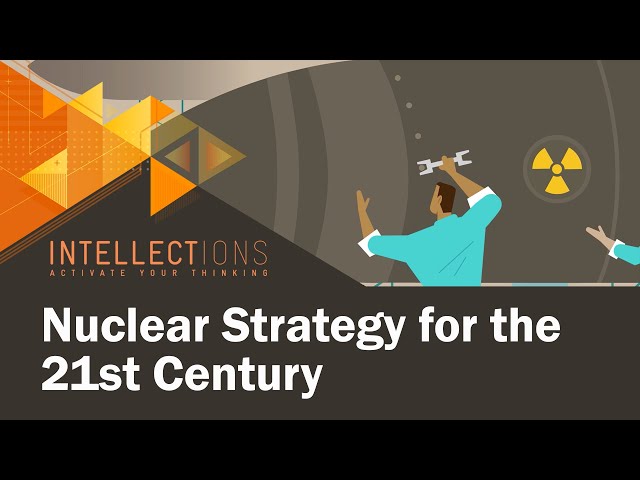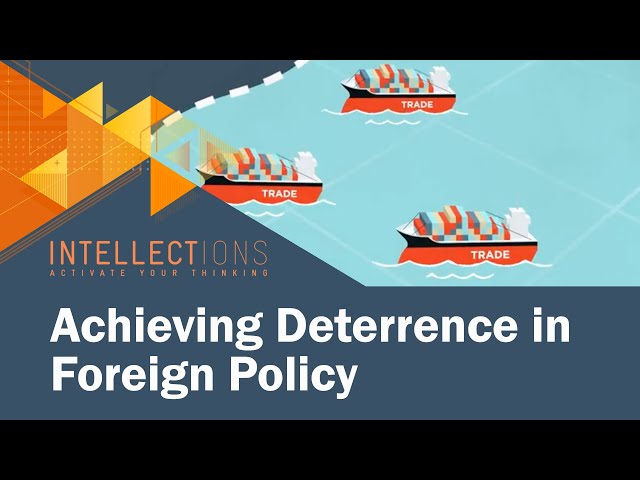
ABOUT THE INITIATIVE
The "World Free of Nuclear Weapons" initiative was established as part of the Hoover Institution's Working Group on Energy Policy. The initiative explores how nuclear deterrence should be understood seventy years after the first nuclear tests. This initiative, chaired by George P. Shultz and James E. Goodby, challenge outdated deterrence theories and show a clear need to reexamine notions from the Cold War that no longer fit present circumstances. They argue that a world without nuclear weapons is a desirable objective that is in the national security interests of the United States.
The initiative examines nuclear deterrence from the vantage points of nations in Europe, the Middle East, and Asia, all of which have some form of security relationship with the United States, either cooperative or competitive. They explain, for instance, why agreement by Poland and Germany on nuclear deterrence and nuclear arms control is necessary if Europeans are to be proactive in reducing nuclear weapons in Europe and. They explore the strategic views, and resulting nuclear policies, of India and Pakistan to determine the possibilities for decoupling nuclear weapons from deterrence. They also tell why successfully reducing and ultimately eliminating the nuclear threat must be based on a combination of regional and global joint enterprises. The initiative focuses on suggestions that might lead to a successful joint enterprise on security among the world’s nuclear powers.
MEMBERS
Sidney D. Drell
James Goodby
Raymond Jeanloz
Henry A. Kissinger
Sam Nunn
William J. Perry
George P. Shultz
PUBLICATIONS FROM THE WORLD FREE OF NUCLEAR WEAPONS INITIATIVE
Articles and Papers
The Threat Of Nuclear War Is Still With Us
by George P. Shultz, William J. Perry, Sam Nunn via The Wall Street Journal
Wednesday, April 10, 2019
The U.S., its allies and Russia are caught in a dangerous policy paralysis that could lead—most likely by mistake or miscalculation—to a military confrontation and potentially the use of nuclear weapons for the first time in nearly 74 years. [Subscription Required]
Imagining ‘A World Without Nuclear Weapons’
by George P. Shultz, James Goodby, Sidney D. Drell, Raymond Jeanloz via The New York Times
Friday, April 15, 2016
“From Hiroshima to a Nuke-Free World” (editorial, April 13) underscored the need for “bolder action” than the Obama administration has been able to take in recent years to move toward its long-term goal of a world without nuclear weapons, a vision that we share.
On Nuclear Weapons, Nations Must Cooperate To Avoid Catastrophe
by Sam Nunn featuring George P. Shultz, Henry A. Kissinger via The Washington Post
Thursday, May 26, 2016
President Obama’s visit to Hiroshima comes almost 71 years after the conclusion of a world war that was fought and ended with tremendous sacrifice, huge casualties and immense devastation. Today, global nuclear arsenals are capable of destroying not only cities but also civilization itself.
Books
The War That Must Never Be Fought
via Hoover Press, March 2015
The War That Must Never Be Fought borrows its title from President Ronald Reagan's State of the Union message of 1984 in which he declared "a nuclear war cannot be won and must never be fought.” He was prepared to challenge theories about nuclear deterrence, which were even then outdated. The essays in this book reveal how much more complex the issue that Reagan raised has become.
Nuclear Security: The Problems and the Road Ahead
by George P. Shultz, Sidney D. Drell, Henry A. Kissinger, Sam Nunn
via Hoover Press, September 2014
Concern about the threat posed by nuclear weapons has preoccupied the United States and presidents of the United States since the beginning of the nuclear era.
The Nuclear Enterprise: High-Consequence Accidents: How to Enhance Safety and Minimize Risks in Nuclear Weapons and Reactors
via Hoover Press, October 2012
Nuclear energy can provide great benefits to society; in the form of nuclear weapons, however, it can cause death and destruction on an unparalleled scale.
The Gravest Danger: Nuclear Weapons
by James Goodby, Sidney D. Drell
via Hoover Press, April 2010
To avoid nuclear war and to contain and gradually to diminish the potential for nuclear devastation: these are the most compelling imperatives of our time."
Reykjavik Revisited: Steps Toward a World Free of Nuclear Weapons (complete report)
via Hoover Press, August 2009
This is the complete report from the Hoover Institution’s "Reykjavik Revisited" conference, held in October 2007.
A World Without Nuclear Weapons: End-State Issues
by Sidney D. Drell, James Goodby
via Hoover Press, July 2009
A world without nuclear weapons is a goal worth pursuing in itself. Beyond that, and most importantly, endeavoring to achieve that goal will also invigorate efforts to prevent the proliferation of nuclear weapons. But the road will not be an easy one.
Related Materials to the Initiative
To Be Listed
MEETINGS
To Be Updated
Policy Education Videos
A New Nuclear Strategy for 21st Century Realities
Contributing Scholars: James Goodby
Failing to move on from the Cold War mindset about nuclear weapons encourages their development and increases the risk that they will be used.
Acting from Strength: Achieving Deterrence in Foreign Policy
Contributing Scholar: George P. Shultz
Deterrence is the ability to prevent an unwanted military action through the threat of consequences, and it is a crucial component of United States foreign policy.
No Empty Threats: Establishing Credibility in Foreign Affairs
Contributing Scholars: Jim Mattis, George P. Shultz
Making empty threats in foreign affairs threatens national security and destroys credibility.










